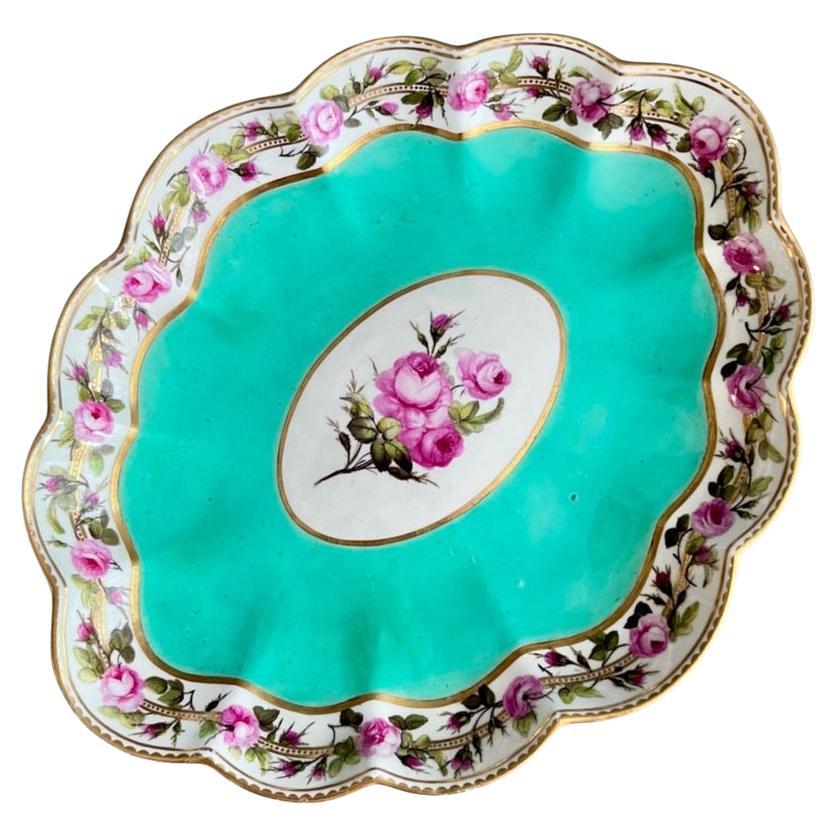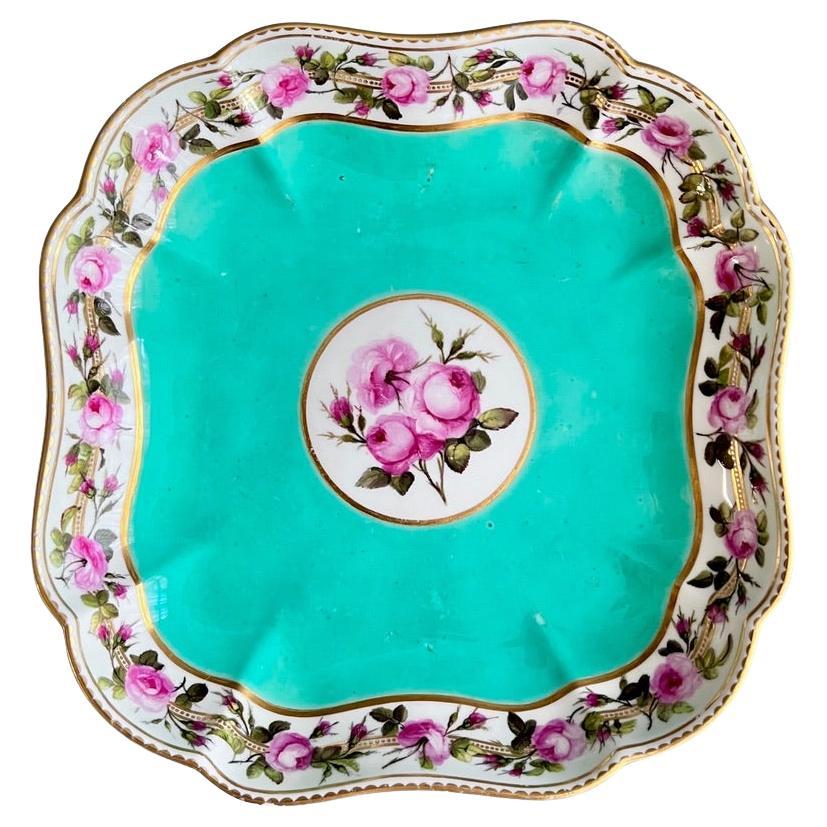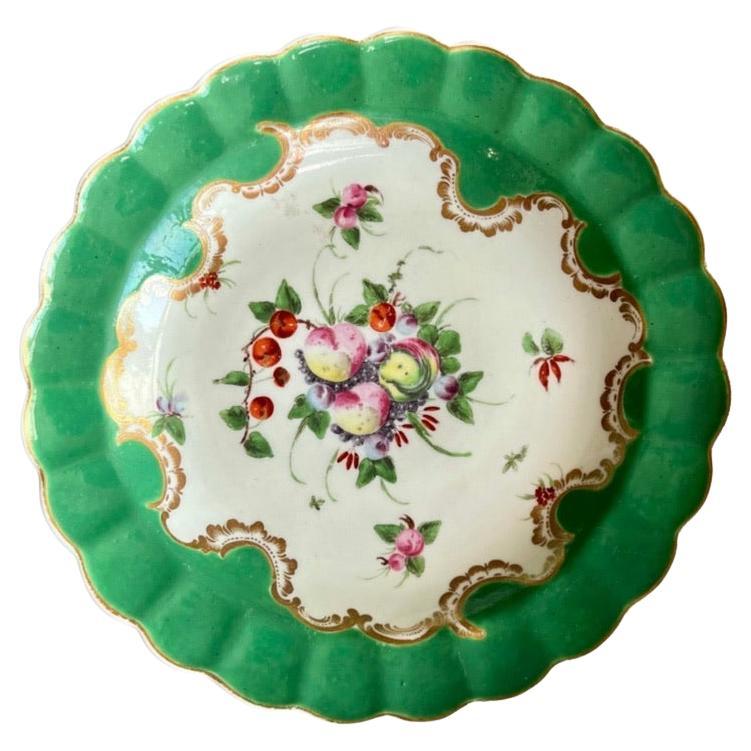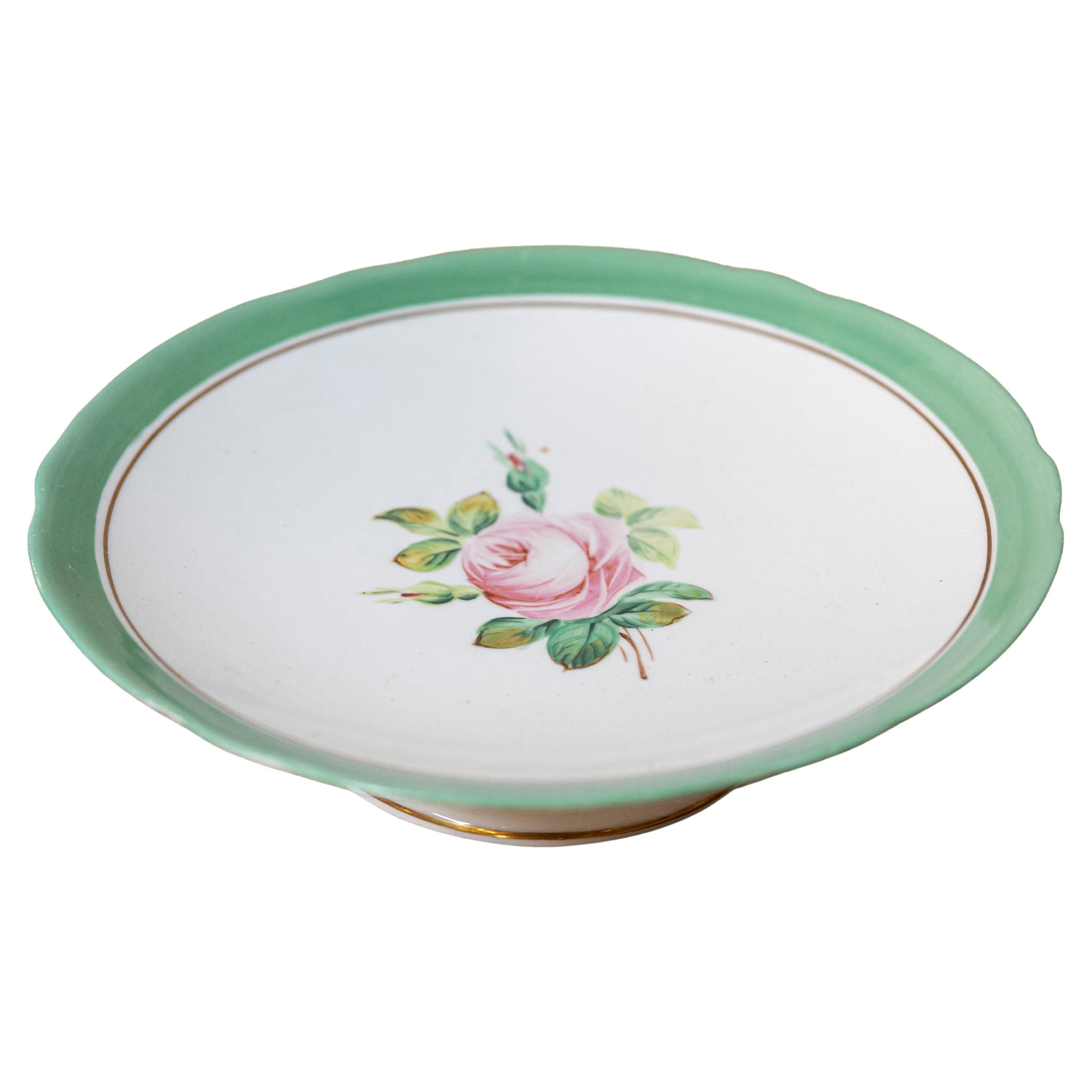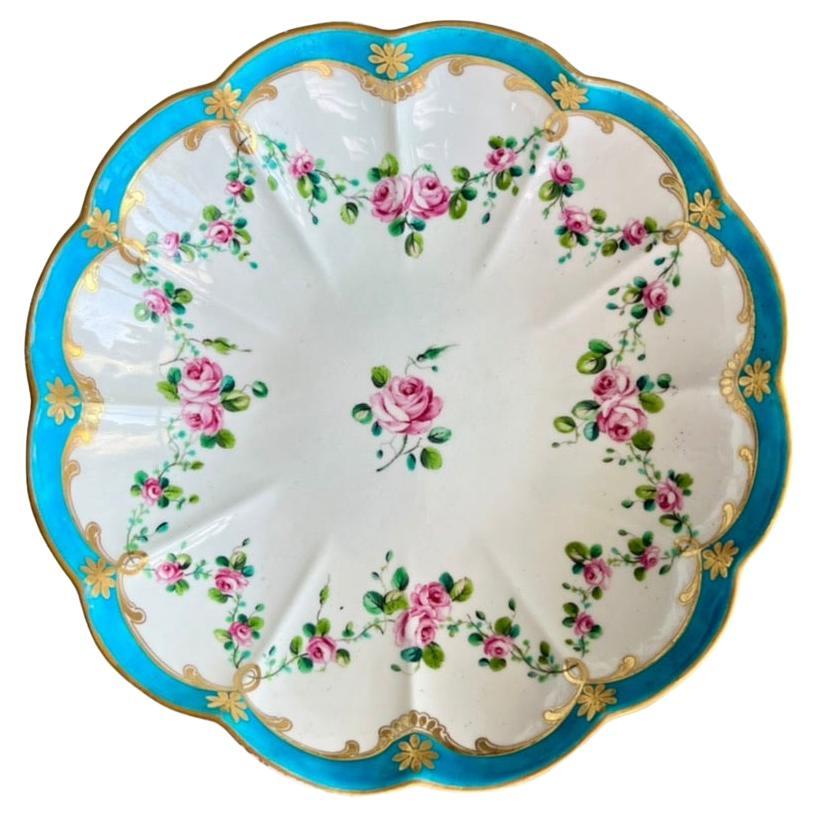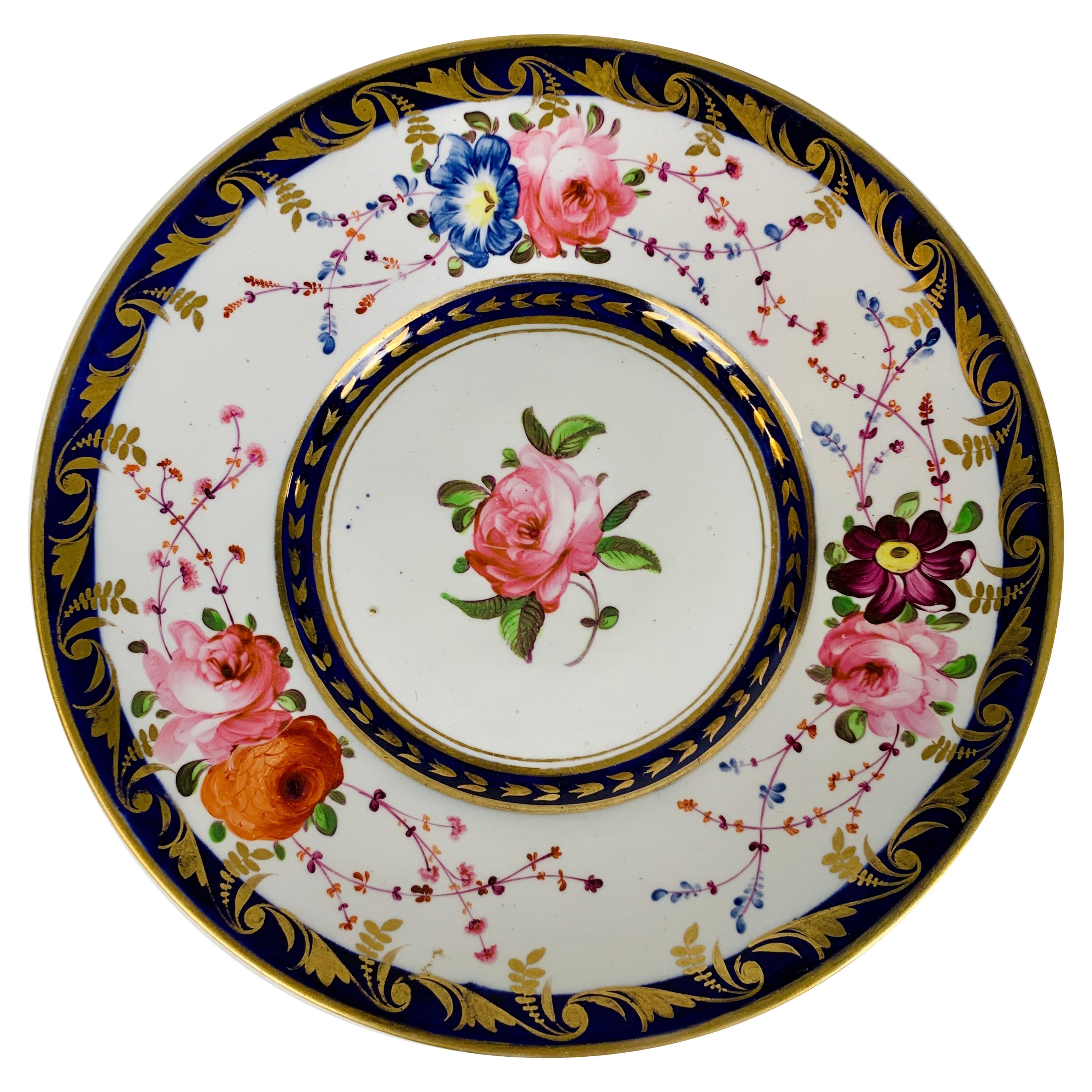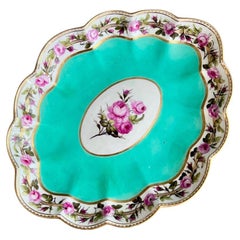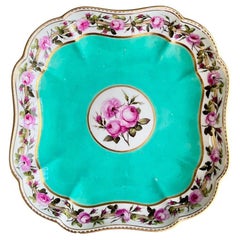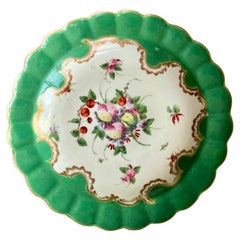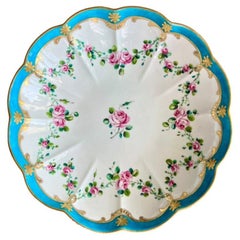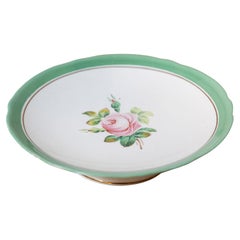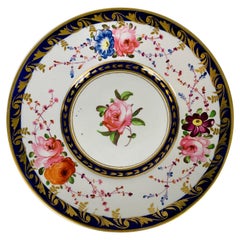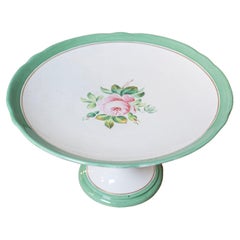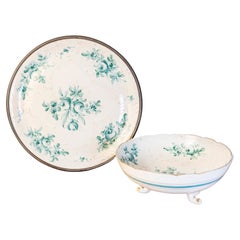Items Similar to Derby Lobed Dish, Camden Service, William Billingsley Roses on Green, 1795 (1)
Want more images or videos?
Request additional images or videos from the seller
1 of 15
Derby Lobed Dish, Camden Service, William Billingsley Roses on Green, 1795 (1)
$3,745
£2,778.94
€3,237.08
CA$5,213.07
A$5,805.22
CHF 3,021.30
MX$71,577.67
NOK 38,478.52
SEK 36,166.08
DKK 24,152.62
Shipping
Retrieving quote...The 1stDibs Promise:
Authenticity Guarantee,
Money-Back Guarantee,
24-Hour Cancellation
About the Item
This is a very rare oval lobed dish from the famous "Earl of Camden" service made by the Derby Porcelain Company in 1795. The service was painted with typical English roses by William Billingsley, one of Britain's most famous painters, and responsible for exactly this type of rose painting on British porcelain.
There are more items available in this pattern, see separate listings. To keep these items together we'd be happy to offer a discount on multiple purchases - please ask!
The Derby Porcelain Company, later called Royal Crown Derby, is currently the oldest British porcelain factory still in production. The Derby pottery was one of the most prominent potteries right from the start of English porcelain production in the mid 1700s to today, and the factory went through many iterations. In the 1820s, it was called "Bloor Derby" as it came under the ownership of Robert Bloor; this factory later closed but its legacy was continued under the ownership of a group of employees, and later this was merged into a new factory called Royal Crown Derby, which is still in operation today and still carries forward some of the oldest patterns that have made it famous over the centuries.
William Billingsley was a brilliant but notoriously difficult man who left behind a trail of debts, broken hearts and mystery - but he was also one of the most important people in the history British porcelain. Billingsley revolutionised the way British decorators painted flowers; he added a freedom and artistry that now singles out British flower painting, and he created a new technique for painting roses, which you can see in this design. Billingsley worked at Derby, Worcester and Mansfield. He also set up his own potteries in Pinxton and Nantgarw and created some of the best porcelain ever made, but racking up great debts, before running off in the dead of night and ending his days at Coalport painting flowers.
Items painted by William Billingsley are rare and very much in demand - together with Thomas Baxter's work they are probably among the most desired pieces of British porcelain.
The Earl of Camden service was a huge service ordered by Lady Camden in 1795. It had to be produced under great, and unrealistic, time pressure and was notoriously late, much to Lady Camden's chagrin. She wanted the service to be produced by only the best artisans and therefore William Billingsley was tasked with painting all items - but it is thought that when it was clear the deadline was impossible to make, he enlisted the help of John Brewer for some of the last items, such as the ice pails. This plate shows the typical "Billingsley" roses: a beautiful naturally flowing garland of English roses interspersed with buds, trailing around a crisp gilt ribbon. The way the roses link into each other, the way each individual one is completely different, the light effects achieved by rubbing out some of the pink paint, and the very fine buds and foliage all point to these being from Billingsley's hand.
This dish came together with a plate that bears labels that point to a rich provenance: the Doris Wheatley Collection, the Daniel Collection, Derek Gardner and the Rowland Williams Collection.
The dish is marked with the puce crowned Derby mark, and the pattern number 185.
Documentation: John Twitchett, "Derby Porcelain 1748-1848, an Illustrated Guide" pages 180-181; John Twitchett, "Derby Porcelain", page 202.
CONDITION REPORT The dish is in excellent condition without any damage, repairs or crazing, and just some surce wear. The green ground is slightly uneven due to the factory's inability to lay an even ground at this early date; this is not wear.
Antique British porcelain is never perfect. Kilns were fired on coal in the 1800s, and this meant that china from that period can have some firing specks from flying particles. British makers were also known for their experimentation, and sometimes this resulted in technically imperfect results. Due to the shrinkage in the kiln, items can have small firing lines or develop crazing over time, which should not be seen as damage but as an imperfection of the maker's recipes, probably unknown at the time of making. Items have often been used for many years and can have normal signs of wear, and gilt can have signs of slight disintegration even if never handled. I will reflect any damage, repairs, obvious stress marks, crazing or heavy wear in the item description but some minor scratches, nicks, stains and gilt disintegration can be normal for vintage items and need to be taken into account.
There is widespread confusion on the internet about the difference between chips and nicks, or hairlines and cracks. I will reflect any damage as truthfully as I can, i.e. a nick is a tiny bit of damage smaller than 1mm and a chip is something you can easily see with the eye; a glazing line is a break in the glazing only; hairline is extremely tight and/or superficial and not picked up by the finger; and a crack is obvious both to the eye and the finger. Etcetera - I try to be as accurate as I can and please feel free to ask questions or request more detailed pictures!
DIMENSIONS 29cm X 23.8cm (11.4" X 9.4").
- Creator:Derby (Maker)
- Dimensions:Height: 1.6 in (4.07 cm)Width: 9.4 in (23.88 cm)Depth: 11.4 in (28.96 cm)
- Style:George III (Of the Period)
- Materials and Techniques:
- Place of Origin:
- Period:1790-1799
- Date of Manufacture:ca 1795
- Condition:Wear consistent with age and use. in excellent antique condition without any damage, repairs or crazing.
- Seller Location:London, GB
- Reference Number:Seller: HP-DER03c-11stDibs: LU4805140717172
About the Seller
5.0
Gold Seller
Premium sellers maintaining a 4.3+ rating and 24-hour response times
Established in 2016
1stDibs seller since 2019
225 sales on 1stDibs
Typical response time: 2 hours
- ShippingRetrieving quote...Shipping from: London, United Kingdom
- Return Policy
Authenticity Guarantee
In the unlikely event there’s an issue with an item’s authenticity, contact us within 1 year for a full refund. DetailsMoney-Back Guarantee
If your item is not as described, is damaged in transit, or does not arrive, contact us within 7 days for a full refund. Details24-Hour Cancellation
You have a 24-hour grace period in which to reconsider your purchase, with no questions asked.Vetted Professional Sellers
Our world-class sellers must adhere to strict standards for service and quality, maintaining the integrity of our listings.Price-Match Guarantee
If you find that a seller listed the same item for a lower price elsewhere, we’ll match it.Trusted Global Delivery
Our best-in-class carrier network provides specialized shipping options worldwide, including custom delivery.More From This Seller
View AllDerby Oval Dish, Camden Service, William Billingsley Roses on Green, 1795 (2)
By Derby
Located in London, GB
This is a very rare oval lobed dish from the famous "Earl of Camden" service made by the Derby Porcelain Company in 1795. The service was painted with typical English roses by William Billingsley, one of Britain's most famous painters, and responsible for exactly this type of rose painting on British porcelain.
There are more items available in this pattern, see separate listings. To keep these items together we'd be happy to offer a discount on multiple purchases - please ask!
The Derby Porcelain Company, later called Royal Crown Derby, is currently the oldest British porcelain factory still in production. The Derby pottery was one of the most prominent potteries right from the start of English porcelain production in the mid 1700s to today, and the factory went through many iterations. In the 1820s, it was called "Bloor Derby" as it came under the ownership of Robert Bloor; this factory later closed but its legacy was continued under the ownership of a group of employees, and later this was merged into a new factory called Royal Crown Derby, which is still in operation today and still carries forward some of the oldest patterns that have made it famous over the centuries.
William Billingsley was a brilliant but notoriously difficult man who left behind a trail of debts, broken hearts and mystery - but he was also one of the most important people in the history British porcelain. Billingsley revolutionised the way British decorators painted flowers; he added a freedom and artistry that now singles out British flower painting, and he created a new technique for painting roses, which you can see in this design. Billingsley worked at Derby, Worcester and Mansfield. He also set up his own potteries in Pinxton and Nantgarw and created some of the best porcelain ever made, but racking up great debts, before running off in the dead of night and ending his days at Coalport painting flowers.
Items painted by William Billingsley are rare and very much in demand - together with Thomas Baxter's work they are probably among the most desired pieces of British porcelain.
The Earl of Camden service was a huge service ordered by Lady Camden in 1795. It had to be produced under great, and unrealistic, time pressure and was notoriously late, much to Lady Camden's chagrin. She wanted the service to be produced by only the best artisans and therefore William Billingsley was tasked with painting all items - but it is thought that when it was clear the deadline was impossible to make, he enlisted the help of John Brewer for some of the last items, such as the ice pails. This plate shows the typical "Billingsley" roses: a beautiful naturally flowing garland of English roses interspersed with buds, trailing around a crisp gilt ribbon. The way the roses link into each other, the way each individual one is completely different, the light effects achieved by rubbing out some of the pink paint, and the very fine buds and foliage all point to these being from Billingsley's hand.
This dish came together with a plate that bears labels that point to a rich provenance: the Doris Wheatley Collection, the Daniel Collection, Derek Gardner...
Category
Antique 1790s English George III Serving Bowls
Materials
Porcelain
Derby Square Dish, Camden Service, William Billingsley Roses on Green, 1795
By Derby
Located in London, GB
This is a very rare square dish from the famous "Earl of Camden" service made by the Derby Porcelain Company in 1795. The service was painted with typical English roses by William Billingsley, one of Britain's most famous painters, and responsible for exactly this type of rose painting on British porcelain.
There are more items available in this pattern, see separate listings. To keep these items together we'd be happy to offer a discount on multiple purchases - please ask!
The Derby Porcelain Company, later called Royal Crown Derby, is currently the oldest British porcelain factory still in production. The Derby pottery was one of the most prominent potteries right from the start of English porcelain production in the mid 1700s to today, and the factory went through many iterations. In the 1820s, it was called "Bloor Derby" as it came under the ownership of Robert Bloor; this factory later closed but its legacy was continued under the ownership of a group of employees, and later this was merged into a new factory called Royal Crown Derby, which is still in operation today and still carries forward some of the oldest patterns that have made it famous over the centuries.
William Billingsley was a brilliant but notoriously difficult man who left behind a trail of debts, broken hearts and mystery - but he was also one of the most important people in the history British porcelain. Billingsley revolutionised the way British decorators painted flowers; he added a freedom and artistry that now singles out British flower painting, and he created a new technique for painting roses, which you can see in this design. Billingsley worked at Derby, Worcester and Mansfield. He also set up his own potteries in Pinxton and Nantgarw and created some of the best porcelain ever made, but racking up great debts, before running off in the dead of night and ending his days at Coalport painting flowers.
Items painted by William Billingsley are rare and very much in demand - together with Thomas Baxter's work they are probably among the most desired pieces of British porcelain.
The Earl of Camden service was a huge service ordered by Lady Camden in 1795. It had to be produced under great, and unrealistic, time pressure and was notoriously late, much to Lady Camden's chagrin. She wanted the service to be produced by only the best artisans and therefore William Billingsley was tasked with painting all items - but it is thought that when it was clear the deadline was impossible to make, he enlisted the help of John Brewer for some of the last items, such as the ice pails. This plate shows the typical "Billingsley" roses: a beautiful naturally flowing garland of English roses interspersed with buds, trailing around a crisp gilt ribbon. The way the roses link into each other, the way each individual one is completely different, the light effects achieved by rubbing out some of the pink paint, and the very fine buds and foliage all point to these being from Billingsley's hand.
This dish came together with a plate that bears labels that point to a rich provenance: the Doris Wheatley Collection, the Daniel Collection, Derek Gardner...
Category
Antique 1790s English George III Serving Bowls
Materials
Porcelain
Worcester Small Lobed Dish, Apple Green, Spotted Fruit James Giles, ca 1770
By 1st Period Worcester Dr. Wall, James Giles
Located in London, GB
This is a beautiful small deep plate made by Worcester in about 1770 in their First or the "Dr Wall" period. It is a small, lobed dish with a deep green ground, elegant tooled gildin...
Category
Antique 1770s English George III Porcelain
Materials
Porcelain
Chelsea-Derby Round Dish, Turquoise with Fine Pink Rose Garlands, ca 1775
By Chelsea-Derby
Located in London, GB
This is a beautiful and rare porcelain round serving dish made by Chelsea-Derby in about 1775. The dish is round and pleasingly lobed, and is decorated in a turquoise rim with gilt a...
Category
Antique 1770s English George III Porcelain
Materials
Porcelain
Coalport John Rose Plate, Abundant Flowers, T. Baxter Studio, ca 1805 (2)
By Thomas Baxter, Coalport Porcelain
Located in London, GB
This is a stunning and extremely rare plate made by Coalport around the year 1805, and decorated in the London studio of Thomas Baxter.
We have one more of these plates in stock, pl...
Category
Antique Early 1800s English George III Porcelain
Materials
Porcelain
Bloor Derby Shell Dish, White, Floral Sprigs Moses Webster, Regency, 1820-1825
By Bloor Derby
Located in London, GB
This is a beautiful one-handled dessert serving dish or "shell" dish made by Derby between about 1820 and 1825 in the Regency era and decorated by Moses Webster. These dishes were to...
Category
Antique 1820s English Regency Serving Bowls
Materials
Porcelain
You May Also Like
English Victorian 1880s Floral Compote with Pink Roses, Green and Gold Trim
Located in Atlanta, GA
An English Victorian floral compote from the late 19th century, with pink roses and green and gold trim. Born in England during the reign of Queen Victoria, this lovely compote features a delicate central rose surrounded by buds and green leaves. The rim is adorned with a lovely shade of green accented with a gold trim that compliments the floral decor beautifully. Showcasing a slightly scalloped edge, the compote is raised on a circular base. With its lovely colors and skillfully executed decor, this English Victorian compote...
Category
Antique Late 19th Century English Serving Pieces
Materials
Faience
Antique English Porcelain Dish Made in England Circa 1820 Decorated with Roses
By Staffordshire
Located in Katonah, NY
A delightful English porcelain dish made circa 1820 hand-painted with exquisite flowers on crisp white porcelain.
In the center is a lovely pink rose. Other roses, forget me nots, an...
Category
Antique Early 19th Century English Regency Decorative Dishes and Vide-Poche
Materials
Porcelain
English Victorian 1880s Botanical Compote with Roses, Green and Gold Accents
Located in Atlanta, GA
An English Victorian botanical compote from the late 19th century, with pink roses, green and gold trim and hourglass-shaped base. Born in England during Queen Victoria's later years, this charming compote features a delicate central rose surrounded by buds and green leaves. The rim is adorned with a lovely shade of green accented with a gold trim that compliments the floral decor beautifully. Showcasing a slightly scalloped edge, the compote is raised on an hourglass-shaped base accented with green and gold highlights. With its delicate colors and skillfully executed decor, this English Victorian compote...
Category
Antique Late 19th Century English Serving Pieces
Materials
Faience
French Limoges Porcelain Bowl with Green Bouquet of Roses and Underplate
By Limoges
Located in Atlanta, GA
A French Limoges porcelain bowl from the late 19th century, with green bouquet of roses décor, petite gilt feet and matching underplate. Created by the AMR factory (Ancienne Manufact...
Category
Antique 19th Century French Napoleon III Serving Bowls
Materials
Porcelain
French Haviland Limoges Petal Shaped Rose Bowl
By Haviland & Co.
Located in Philadelphia, PA
An unusual shaped porcelain bowl from Haviland Limoges, France – circa 1900.
Decorated by hand on both the front and back with running borders of Pink roses and green leaves.
The s...
Category
Antique Early 1900s French Romantic Decorative Bowls
Materials
Porcelain
Antique Porcelain Dish Pink Roses Hand Painted England Circa 1820
By Coalport Porcelain
Located in Katonah, NY
This exquisite antique porcelain dish was hand painted at Coalport Porcelain in England circa 1820.
It is a piece of artistry that has gracefully withstood the test of time.
The dish...
Category
Antique Early 19th Century English Regency Decorative Dishes and Vide-Poche
Materials
Porcelain
